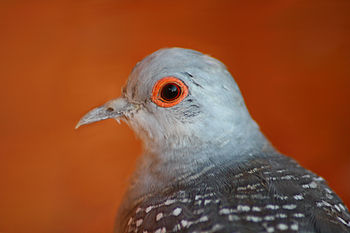 |
| Carrier Pigeon (Photo credit: Wikipedia) |
You may picture them carrying messages between secret lovers and aiding in espionage, but this is not all they are used for. In the past, they have been used for some very important tasks such as sending orders for military officers, snapping aerial photographs, and even delivering fragile medical items between two hospitals. They even once made themselves useful by carrying the film from photographers in the field back to their photo labs to be developed when the time was of the essence.
When homing pigeons are used for sending messages, they are called 'messenger pigeons.' Since homing pigeons have the ability to find their way back home across incredible distances people developed a system called 'pigeon post.' This works by trading pigeons with each other so that the owner's pigeon can carry the message back to them.
For example, two people might trade three pigeons with each other and go their separate ways. They then have the ability to send three messages to each other via pigeon post. Once they have sent three messages each, they would need to meet again to trade more pigeons. This minimized the amount of traveling they would need to do which was a very nice convenience when traveling was more costly and dangerous than it is today.
For example, two people might trade three pigeons with each other and go their separate ways. They then have the ability to send three messages to each other via pigeon post. Once they have sent three messages each, they would need to meet again to trade more pigeons. This minimized the amount of traveling they would need to do which was a very nice convenience when traveling was more costly and dangerous than it is today.
Along with the many wonderful stories about these birds come many misconceptions. For one, they are often thought to be extinct, but they are not. The passenger pigeon is the one that was driven into extinction. Yet another common misconception is that a carrier pigeon is a breed of pigeon. A homing pigeon is a breed that is mostly used as a carrier pigeon. Carrier pigeon is just the 'job title' of some homing pigeons. Similarly, someone wouldn't say that the breed of a guide dog was 'guide dog.' No, you would call the dog by its actual breed, such as golden retriever.
How to Train a Homing Pigeon
A Homing pigeon's instinct is to always fly back to where they live, especially if they have a mate or squabs. Using this knowledge, the first step to training a homing pigeon is to have it learn where its home is. To do this, the owners will keep the pet pigeons in their enclosures for several months. Usually from the time they are young until they are they are grown. This is more difficult with adult pigeons because they may already have a place they call home. During the months of keeping the birds in a cage, they should be kept well fed with a proper diet of pigeon feed.
After their stay in the cage, they will know where their home is. From now on, most pigeons will always return to this spot and when let out to fly. A very small percentage of pigeons will leave and not return. They then go and live elsewhere, becoming feral pigeons. Once the pigeons home is established, they will slowly be able to find their way back home longer distances. This homing skill can make them useful as carrier pigeons.




